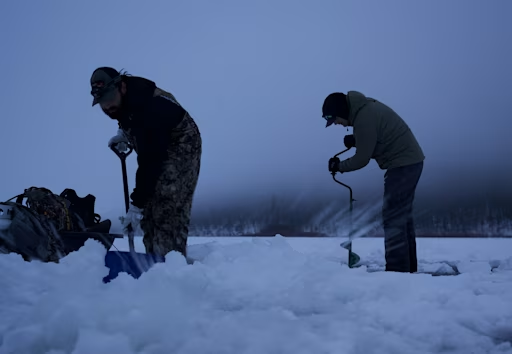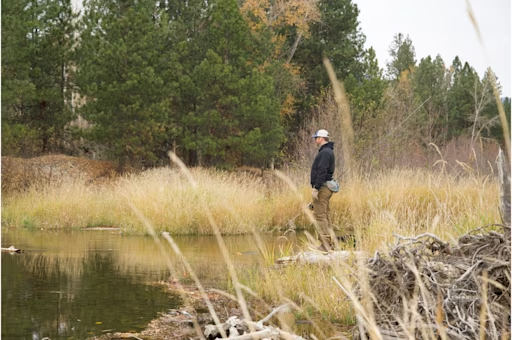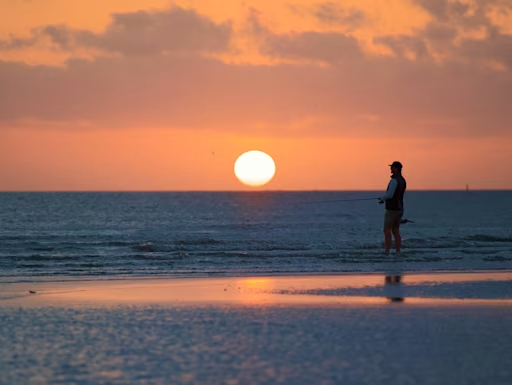How to get started bass fishing: From gear to etiquette
Learn everything a beginner Bass angler needs to know - from gear to etiquette, this complete guide has you covered.
Share this article

I seldom ever see an article that is written clearly and concisely about how to begin catching Bass. When I began, my interest grew much quicker than my expertise - and for a long time, I was doing things wrong. I tried to learn by Googling guides, etc... but I would just end up with fifty tabs open looking up jargon.
So this is the goal: Step by straight-forward step get someone who knows almost nothing about fishing to a body of water with a fish in hand. While it may be a bit wordy, most of the necessary information is included in this guide and it may even enhance an old hands knowledge by refreshing the basics.
Step 1 - Get Some Gear:
Rod/Reel: Start small and light. Grab a short (5’ 6” - 6’0”) light or ultra-light Spinning Rod (think about Baitcasting rods later). Moderate to fast action is fine. This will help you learn to control and sense the Bass, which is critical to expediting your skillset. Make sure you pair the correct size reel with the rod, which should be a 1500-2000 size spinning reel, bigger ones will work but balance becomes an issue.
For budget getting started, there are several Rod and Reel Starter Combos. You can find everything here from the Tailored Tackle Multispecies Combo (which will work for a starter combo) to the high-end stuff like the Favorite Fishing Jack Hammer combo.
If you don’t want to shop online, for durability and price nothing beats an Ugly Stik GX2 5’6 Light Fast paired with a Pflueger President 1500 or 2000 size Spinning Reel, it will run you around $80 bucks for the combo ($35 rod/$45 reel) but you probably won’t ever have to replace either one unless you knock an eye off the rod. You can find the combo at most local US retailers. With such a short, light, rod sensitivity isn’t an issue and it’s hard to break it on accident (besides the eyes on the rod), which may be a worry when you’re starting out.
This is a toss-in-the-back-of-your-truck combo that will perform just as well as anything in the light/ultralight family of combos below the $200 tier. The Ugly Stik line of rods are heavy and this is their biggest drawback, however with the light/ultralight rods in the series the weight isn’t too noticeable and actually helps with casting distance. I spent a lot of time figuring out this combo when I started because of my budget.
If you’re completely broke… or just don’t want to spend money on something you don’t know if you’re going to pursue long-term, go bum a rod and reel off of a friend or a neighbor. Half of the people you know probably have an unused combo just laying around in storage somewhere. If you need to learn how to use an open-faced spinning reel, there are tons of very simple tutorials online.
Line and Drag:
Start with 8 lb. Test Fluorocarbon line. Test is the amount of strength that it took the manufacturer to break the line (at a minimum) during their testing procedures. Many anglers have favorite brand, but I find that most name-brands perform similarly. There is Seaguar in the shop which is a reliable brand that I use often, make sure you select the 8 lb. option, again if you’re not into online shopping go to your local outdoor or big box retailer, just don’t buy generic. You will find that most common name brands do exceed this minimum though.
Many beginners start with line that is much too heavy, thinking incorrectly that if they have a fish hooked with a weight that exceeds the test limit that it will break the line. Because of the way buoyancy effects the Fish's weight and your leverage (not to mention several other factors) effects the Fish’s strength, as long as your drag is set correctly and the fish doesn’t wrap your line around structure, this simply won’t happen.
Most anglers agree that the smaller diameter line you use, the more bites you will get. There is much more to this and heavy line has its applications, but for beginners: use lighter, clear line, skip the red line myth (Bass can see color) and stick to water that doesn’t have a ton of vegetation or thick stuff. If you are still worried about “breaking off” you can use 10-20 lb. Braided line instead, but fish, especially Bass can see and feel Braid easier than Fluorocarbon. Make sure you check out a tutorial on how to spool (load) line on to a spinning reel correctly when you are a beginner. I see advanced anglers doing this wrong all the time and I was guilty of it as well for far too long.
Drag:
Drag, explained simply for the beginner is the amount of resistance your reel has to line being pulled from the spool (the ridged metal bar that the line wraps around) when the bail (the metal bar that opens and closes on a spinning reel) is closed. Drag can take a long time to master but can be understood and applied in relation to a Spinning Reel easily with this rule of thumb for beginners: Set your drag to start with (the knob that turns in the front, under the bail of your reel controls the resistance) so that you can pull line out (just barely) without having to strain to do so, if you are of average strength. Too light on the drag and you will miss hooksets, or the fish, if it is big, will run off with your line, getting your line and possibly itself hung up in the process.
A Lure and a Knot:
In the spirit of this guide staying straight-forward I am going to forfeit the details of spooling, maintenance, knot tying and technique. As per usual, there is plenty of information outside of this article to be Googled. However, I would like to suggest you learn to tie a Pitzen knot. This knot can be used to tie line on to the spool, to tie on a lure and even to tie a leader on when doubled. It is literally the do-all knot of fishing and it reportedly has 90% of the strength of the line, which is much higher than most fishing knots. If the Pitzen is too much, then learn to tie at least a Palomar, which is easy to learn and acceptable for beginners. NEVER use an overhand knot when tying line to a lure. It will halve the strength of the line.
Lure:
For the starting Lure on a combo like the one I suggested, I would highly recommend using the 1/10th Oz. ZMan Finesse Bullet Headz. These things are just magical. They are searchbaits, they are power baits and finesse baits, they are light enough to set the hook on a fish with an ultralight rod but are sturdy enough to pull big fish hard as well without any worry of breaking. They will also teach you how to Texas-rig a plastic bait (look up a tutorial online) which is one of the most important skills for a new Bass angler to learn. These things can catch multiple species of fish which is fun when things slow down with the Bass. Can’t really beat ‘em for a do-all lure.
Trailer/Soft Plastic:
They pair perfectly with the ZMan TRD from the store for Finesse, but if you’re going to pair them with just ONE do-all bait, use them with the ZMan Slim SwimZ. With a perfectly matched paddle tail they can be used as a Swimbait, Shakey Head, Bottom Jig or even a Topwater if you get skilled at it, all with one Jig and one Soft Plastic. There aren’t many other lures that you can pattern a fishery using just a single bait, but this lure combo will catch fish any day of the year on any lake with Bass in it, which makes it my top choice for Casual/Beginning anglers. I won’t get too much into color selection either but as a starting rule of thumb, the darker the water, the darker your lure color should be.
Step 2: Finding Fresh Water and Bass Habitats
It can be difficult in many places in the continental US to find fresh water without at least one species of Bass present. Still waters such as ponds and lakes generally contain Largemouth Bass, which are the most common species and moving water such as rivers and large creeks generally contain Smallmouth (in the northern 2/3rds of the US) or Spotted Bass, however all three common species can inhabit most freshwater zones.
So, using the Fishbrain app, an online map, Google Earth or even a regular old paper map, locate a body of water that is close to you and that you can access. As stated earlier Bass will be present in water more often than not and they can even inhabit places that you would think no fish could live in, such as Golf course and apartment ponds and even retention and drainage ditches on the side of the road. If you have a neighbor with a pond or other water access and you don’t, don’t hesitate to ask for permission. It usually never hurts to ask.
Where to find Bass in the water:
Again there are better articles than this on dealing with the places Bass like to hide (they are ambush, not generally pursuit predators) or “structure”, but the beginners rule of thumb for this is: The warmer the water, the shallower and closer to shore they will be and Bass love hiding spots such as fallen logs, big rocks, weeds and grass beds in the water, just get used to thinking like a hungry Bass. There are many exceptions to these rules that can be learned outside of this article however. Cast around, on top of and even into good looking hiding places, especially ones near where you see smaller fish (or baitfish) activity nearby. The lure described earlier will keep you from getting snagged most of the time in these places, just don’t forget to check to make sure your hook point is “texposed” or still embedded inside the top of the lure after every few casts, or every bite. You can reel this lure back in, stop it, let it sink and shake it, hop it or pretty much do anything you want with it!
Step 3: Catching and Handling a Bass
So you’ve followed all of the steps so far and you finally feel that bite! Don’t set that hook just yet! Remember… give the fish a couple of seconds to eat the lure. With smaller, softer lures like this, you don’t usually need to worry about the fish feeling that the material is wrong and spitting it out immediately, so giving the fish to the count of three is usually a good idea, unless they’re being really aggressive.
The Hookset:
When you do set the hook, reel the slack up out of your line until you can feel the fish moving, or your rod tip starts to “load up,” or bend a bit. If you can feel pull or resistance, set the hook by pulling the rod up and into your body, away from the direction that the fish is moving with a quick, snapping motion. You don’t really need to go crazy with the hookset when you have a smaller hook tied on and setting the hook with too much “oomph” can hurt the fish.
With a smaller combo, try to keep the fish hooked by not allowing any slack in your line and by keeping your rod tip pointed up at a “1 to 2 o’clock” angle while landing the fish. The hook can often miss the roof of the mouth (which is the ideal place for the hook to penetrate) and cut through the cheek, causing a hole from which the lure can be “spit” or dislodged by the fish when it jumps or fights. Slack in your line only gives the fish a higher chance of escaping if this happens.
Handling and treating the Bass with respect:
Too many articles I see written for beginners skip entirely how to handle a fish respectfully once it has been landed. You may have seen pictures posted by people with a fish next to their shoe or rod on the ground as an improvised frame of reference for size by the angler. Fish are sensitive creatures and although Bass are more resilient by far than most other species, they still have a delicate “slime coat” that acts as a buffer between them and microbes in the water that would like to use them as a home, or food. Putting a fish on the ground, no matter what species, can partially destroy this coat, resulting in problems for the fish after it is returned to the water, if it is not intended for consumption.
I have also caught more than my share of fish with hooks still in the mouth and even partially digested lures hanging out of their mouths or rears. Make sure you have a pair of pliers and learn etiquette online for handling a “gut-hooked,” or deeply hooked fish and be sure to throw your plastics away responsibly.
I have never caught a fish that I have had hooked so badly that I could not safely remove the hook from it, without further damaging the fish. The only exception to this is that sometimes you may hook a fish through the eye. If this happens, remove the hook (sometimes cutting the line or cutting through the hook with pliers and removing it backwards if you can helps) at your discretion and try to do minimal damage to the animal.
Although it is true that fish can’t perceive pain on a level that humans can, it is obvious to the expert that they do feel pain and having at least a modicum of respect for other living creatures should be part of everyone’s agenda in an ideal world.
So, I try to go by these few rules when fishing:
1: Don’t throw trash, line, or used lures into, or around the water. Keep a small receptacle for trash with you.
2: Have respect for wildlife. We do enough damage to our environment.
3: Respect other people, especially anglers and put safety first.
4: Handle Fish with care, when taking a photo by yourself with a fish over two pounds, hold it by the mouth with as large of a grip as possible and for as short of a time as possible. Holding a large fish up by a small area on the lip can damage its jaw, especially if it is for an extended period of time. If you can, use both hands, one in the mouth and one on the belly of the fish for support. Please, also keep fish off the ground.
5: Practice quick CPR (Catch, Photo, Release) unless culling or eating fish. Bass can survive for a while out of water, but the longer they are out, the more stress they take and the more “pressure” (or resistance to artificial lures) you apply to fish in that area. Giant fish produce giant offspring and the bigger a Bass is, generally the worse the meat is.
Bass fishing can enhance your life in many ways but for me, it fills the need for a hobby and purpose, gives me exercise and time to meditate and decompress in some of the most beautiful surroundings you can experience. What it becomes for you, is for you to decide, but I highly recommend it and I hope this guide helps! For more gear you may want for starting up, or just in general don’t forget to check out the Fishbrain Store and check out the humongous Fall Sale! Tight lines Fishbrain fam!

Download the Fishbrain app and access the best fishing spots in your area
Related blog posts
Master the hardwater season with advanced ice fishing tips . Learn how to find fish faster, refine your search and adjust presentations to catch more fish all winter long.

Your guide to Victoria’s best fish to catch in rivers, lakes, and coastal waters. Learn prime species, fishing tips, and key regulations

Learn how fish adapt as water temperatures cool from autumn to winter, including changes in behavior, metabolism, and habitat that help them survive.




